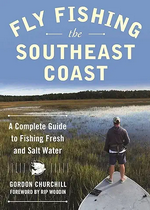FLOATING LINE
This is the line you will with use most frequently.
For short, fresh water casts, you can stand facing the target and cast with your dominant hand over your dominant shoulder, bending your wrist sufficiently to get the back cast behind you. Begin with your rod tip close to, or even in the water, so that you can get all of the fly line out of the water (the leader and fly will still be in the water) before making the Hurry Up and Stop (Lefty Kreh’s designation for the end of the cast, even though it looks a lot like a power cast). But you want speed, not power. Your line hand is what gives you distance, not your rod hand. Give your back cast time to unroll before starting your forward cast. Again, start slowly to a Hurry Up and Stop. Keep the rod tip in the same plane until the very end, after the Stop, when you pull down the tip of the fly rod to get it out of the way of the line and fly, which would cause a wind knot or a collision with the rod which would weaken it and eventually lead to breaking the rod.
For longer casts (salt or fresh), you need to increase the line speed so the line goes further in the same amount of time it takes a short cast to hit the water. So, it is important to load the rod deeper by extending the length the rod travels before what Lefty Kreh calls The hurry-up and stop. You don’t apply more power but you must bend the rod more by having a longer distance for acceleration and having a more robust double haul. In making the longer casts, avoid breaking (bending) your wrist in the rod hand as much as possible until the very end of the forward cast when you dip the rod tip down just enough to let the tight loop miss running into it and causing eventual damage to the rod, not to mention the possibility of a wind knot (Lefty says it should be called a bad cast knot). A lot of wrist bend during the cast will cause a very open loop that expends its energy going up instead of forward.
For both the back cast and the forward cast, the haul is executed at the same time as the Stop. This bends the rod and speeds up the line, resulting in more distance. In both cases, a tight loop is important in directing the line toward the intended target. The less one bends the casting hand wrist in making the cast (until the final dip of the rod tip), the tighter the loop will be. Remember, the line will go where the rod tip is pointing when the Stop is executed on both the back and forward casts.
SINKING LINE
Sinking line comes in a variety of forms from slow sinking to fast sinking. In all cases, the heavier weight in the line may cause harm to the rod if it is forced to change direction too abruptly. This will shock the rod and ruin the cast, possibly breaking the rod.
Instead, make a cast in the form of a horseshoe in which the back cast is made side-armed and the forward cast is made more as an overhead cast or a less pronounced side-armed cast. The idea is to keep the weighted section of the line from having to stop. You want it to make a giant curve.
Intermediate line is a lightly weighted sinking line. Cast it as you would sinking line, even though it is lighter than other lines that sink. The horseshoe cast that keeps the tip of the line moving at all times, may not be as vital as in heavier sinking line, but why take a chance on breaking an expensive rod?
In most cases, you want a fairly short leader & tippet when using sinking line. This will keep the fly from floating too far off the bottom.
DOUBLE TAPER LINE
Double taper line has a short taper at the front and back so the line can be attached to the leader in front and backing in the rear. The majority of the line carries the same diameter from the front to the rear. It is not very good for long casts but, because it is the same diameter (and weight) from front to rear, it is much easier to mend- an essential task in fishing streams.
Don’t forget to check out the resources of Fly Fishers International at www.flyfishersinternational.org.
Also, Google this and other topics of interest and go to YouTube for seemingly endless videos.



